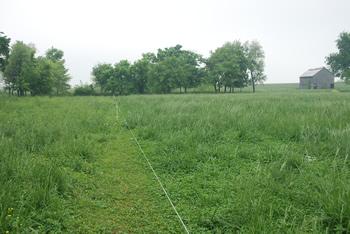Use of Temporary Fence
 The practice of rotational grazing allows forages a rest period that permits them to initiate regrowth, renew carbohydrate stores, and improves yield and persistency. A rotational grazing system divides a larger pasture into smaller paddocks allowing livestock to be moved from one paddock to another easily. The time spent grazing a paddock should be flexible depending on the paddock size as well as the weather, forage availability, and plant growth rate. Having a movable or temporary fencing system allows for maximum flexibility, especially for those just beginning to practice managed grazing.
The practice of rotational grazing allows forages a rest period that permits them to initiate regrowth, renew carbohydrate stores, and improves yield and persistency. A rotational grazing system divides a larger pasture into smaller paddocks allowing livestock to be moved from one paddock to another easily. The time spent grazing a paddock should be flexible depending on the paddock size as well as the weather, forage availability, and plant growth rate. Having a movable or temporary fencing system allows for maximum flexibility, especially for those just beginning to practice managed grazing.
When choosing a temporary fencing system for your operation, it is good to have an understanding of the different fencing materials that are available. There are several different combinations of electric fencing wire, posts, and energizers to choose from.
Since temporary fences are electrically charged with an energizer, it is good to know which type will work best for your operation. There are two main types of fence energizers, high-impedance and low-impedance. High-impedance chargers have long pulse lengths that can cause current to arc and heat up in the wire. If the fence comes in contact with weeds and grass, it can cause a fire and melt polywire or polytape. Low-impedance chargers resist arcing because they have a quick, intense pulse. Low-impedance chargers have a greater capability to power long distances of single or multi-wire fences.
Even though there are only two types of chargers, there are different variations of each type. Many brands offer an AC-powered charger (plug-in), a battery-powered (DC) charger, and a DC powered charger that has a recharging system (voltaic or solar panel) built into the unit, known as “solar-powered” charger. If your fields are close to a power source, an AC-powered charger is your best source for reliable power, and is generally less expensive than DC-powered chargers. When this is not an option, use a DC-powered charger of your preference. The “solar-powered” unit is more expensive at initial purchase, but will require less attention than a DC charger that requires the batteries to be replaced and recharged periodically. It is generally recommended to buy the best charger you can afford because it is the foundation of your temporary fencing system.
There are two basic types of temporary electric fence wire on the market: polywire and polytape. Both are made up of fine metal filaments braided with strands of plastic fibers. Most producers use polywire instead of polytape because it is less expensive. However, polytape is more visible to livestock and deer but also has greater electrical resistance. Polywire is offered in different colors. The color should contrast with the surrounding and white is the most common because it is more visible to cattle and deer than most other colors. Many brands offer different variations of both polywire and polytape related to how many strands of metal filaments are in the wire. The more metal strands, the more conductive the wire and the more expensive it is. Higher strand polywire/polytape also tends to last longer. A wire reel is the next essential piece to aid in moving the temporary fence. Rolling wire around your arm, like an extension cord, or onto a stick will cause the wire to kink, causing the metal filaments to break and the wire will not conduct electricity properly.
When installing a temporary fence, four different types of posts are available. Plastic posts with built-in treads are more convenient when anticipating moving the fence frequently because they allow one to step the posts into the ground and have pre-molded loops for wire. Plastic posts are made from a heavy duty, UV-resistant polymer compound so they will last longer, even though the life expectancy is only three to five years for this style of post. Metal pigtail posts that are step-in are also available and these have a loop to run the wire through. These are slightly more expensive than other styles of temporary posts. Fiberglass rods are better for situations when the fence is not going to be moved as often because these have to be hammered in the ground. These rods require the use of wire clips or plastic insulators that slide on the rod to hold the wire in place, or have holes drilled through them with cotter pins holding the wire. They are less expensive than plastic posts and can last up to 20 years. Many producers use 3/8” metal rebar posts accompanied by slide-on plastic insulators. These posts are hammered in the ground as well, and are cheaper and last longer than plastic or fiberglass posts. Metal “t” posts are the strongest and last the longest of temporary posts, but they do require more labor to install and remove, and are also more expensive than the rest. Insulators can be lost as well from deer running through the fence. These are less flexible than the other types but work well as corner posts or when making sharp turns in the fence line. The general distance between posts in a fence is between 20 to 30 feet, depending on the terrain of the land.
A fencing setup that works for someone else may not work for you. Depending on how many times you move the fence, the temperament of your animals, and expense are all factors that you will have to consider. Using temporary fence correctly can help you implement an effective managed grazing program.
Categories:
Spring
Grazing Systems


